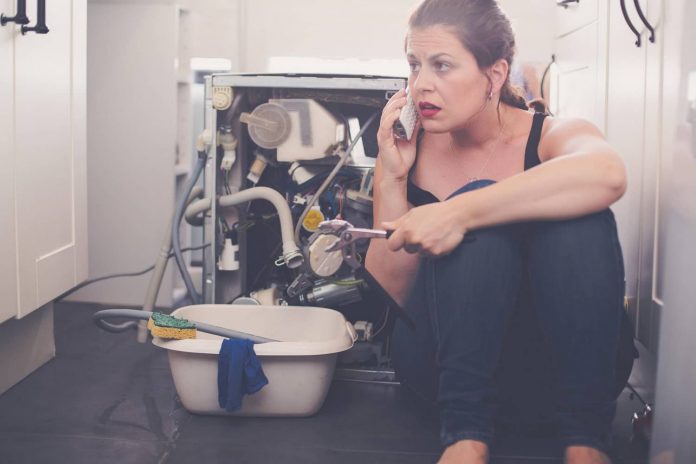In the best of homes featuring the most impeccable construction, a sudden and surprising leak can occur from many places.
And while the washing machine is leaking within a home can vary, they tend to show up in the appliances and installed fixtures that channel the largest volumes of water.
These include washing machines, dishwashers, toilets, sinks, and shower/tub drains. Determining the exact location is typically a fairly straightforward process, with the only possible exception being when it involves moving a heavy appliance.
Washing Machine Leaking: Top 6 Reasons
Then, the most difficult situation you will most likely ever face will be when your (full and running) washing machine is suddenly situated on top of a water puddle that is increasing in size by the minute.
 Making it, Better Often Requires Making it Worse, First.
Making it, Better Often Requires Making it Worse, First.
The only time a washing machine is going to reveal the presence of a leak source is when it’s got water in it, and most often, when the leak presents itself, it is when you are running a full load of laundry, with the greatest volume of water in the tub.
The most frequent causes of leaks from a washing machine are from tubes and seals. Then, the most difficult element ahead of you will be to move the washing machine out from where it’s situated so that you can manage to visually assess and access the sides and back of the machine.
Amazing to discover just how heavy a washing machine full of clothes and water can be. And even though it’s most likely going to result in even more water leaking from the process, you will probably have to run the machine on the drain portion of the cycles to get rid of the water in the tub.
You may also need to remove all the wet clothing from the machine, storing them temporarily in one or more clean laundry baskets. Your washing machine should, at this point, be much lighter, allowing one person to move it fairly easily without assistance.
The Most Common Causes of Washing Machine is Leaking
When your washing machine is operating in the spin cycle, this is when water is drained out. If it is only during the spin cycle that your washing machine is leaking, the most likely cause of your leak is going to be found in one of two drain hoses that channel water from the machine.
However, the good news is that you can generally rule out the possibility of damage to the machine’s water supply hoses with such an occurrence of leaking. When a washing machine’s water supply hoses cause a leak, they tend to drip continuously. The only way you can be sure of the leak’s source will be by first unplugging the machine and then opening the cabinet to investigate the problem’s source visually.
First, Check the Hoses
When your washing machine begins to leak, please do not allow your mind to immediately wander to the verdict that you now need to replace it, regardless of its age and condition. With the cabinet off and the inner components accessible, you will get more information on just what is going on and its seriousness.
The washer tub and the pump to the external drain are connected to the pump by two large drain hoses. Sometimes the only repair needed will be to tighten down the clamps at the connection points, so first, check all four places and check for signs of looseness.
If the problem is with the clamp, tighten it down. If the hose has lost its elasticity from age, it would be best to replace the hose with a new one. Other signs that these hoses need to be replaced will be when they become brittle and have any splits or holes. Often, when these hoses are the leak source, you’ll find that the water drips and leaks are right beneath the hoses. Other indications of a leaking hose might be calcium deposits, rust, or other types of stains that can form around the hole or split.
When the Problem is the Pump
The function of the washing machine pump is to draw water from out of the tub and channeling it to the drain. The pump is connected to something else; seals are included that prevent water from leaking during pump operation.
As these seals are made from materials that are very similar to or the same as those from which the hoses are made, they are subject to all the different types of malfunctioning from age. Often, the pump seal that is the culprit is the pulley seal. This can be found when the drive shaft enters the pump on both direct drive and belt-driven washers. A leaking pump almost always requires replacement.
Other Seals to Check
For a washing machine that generally leaks at different times during its cycle, instead of only when water is being drained out, the problem could be with one of the other washing machine seals.
There are more tub seals located at the bottom of the outer tub. The center post gasket under the agitator can sometimes be a cause of leaking. Other spots to check at this point would be the air dome seal.
It is mounted on the side of the outer tub, and its function is to help control the level of water during both washing and rinsing cycles. When the gasket fails, the leak will occur during the water emptying stages of operation.
Another Cause?
Now, if all the above methods fail to produce the cause of your leak, the problem could be coming from a less mechanical issue. It’s a fairly commonly made misconception that if a little detergent cleaned effectively, then by adding more, Who would improve the cleaning. What happens when too much detergent is added to the tub is referred to as oversudsing, resulting in an overflow.
If this ever happens to you, effectively reduce the amount of suds by mixing a little bit of vinegar with water in a bowl or pitcher, with a ratio of approximately? Cup vinegar to a quart of water and add it to the washer contents. The excess of suds should quickly dissipate.
Also Read:











